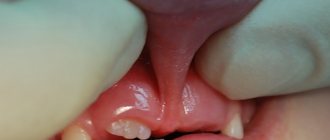Unfortunately, even parents who are not privy to medical subtleties are familiar with the opinion that a short frenulum of the tongue in a child is the cause of speech therapy problems.
Why "Unfortunately"? Because it is ignorance of the material that leads to a clear decision - the bridle needs to be trimmed! Do you remember in the film “Pokrovsky Gate” the characteristic female surgeon with her famous phrase “Cut!.. without waiting for peritonitis”? So the same thing often happens to the poor bridle. However, as experience shows, there is not always only one way out. Not every case of the so-called “short frenulum” requires radical measures.
What is a short frenulum of the tongue?
The frenulum is a thin partition that connects the tongue and the lower oral cavity. Normally, the frenulum is quite elastic, stretches well and is attached to the tongue in its middle part.
An abnormal structure may be the location of the frenulum closer to the edge of the tongue or even at its tip. In addition, a significant decrease in its elasticity, that is, its ability to stretch, is possible.
So in fact, the concept of “short bridle” is not entirely correct. Therefore, there is no clear solution to this issue.
Drawing up a correction program
It depends on the form of the sound pronunciation disorder. For example, a child may have no vibrant in his speech at all, or he may replace it with other sounds or mix them. Rotacisms, that is, distortions, are also common. There are 8 types of rotacisms. Therefore, the speech therapist selects a step-by-step production of the sound “r” individually for each little patient. However, there is a list of exercises that are suitable for any form of vibrant pronunciation disorder.
“Imitation” technique for simple cases
The staging exercise involves auditory perception of sound. The little student is offered examples of phonemes, for example, the roar of a motor, thunder. And he, sitting in front of the mirror, repeats what he heard.
What is the problem with the incorrect structure of the frenulum of the tongue?
In infants, an abnormal frenulum structure can cause difficulty sucking. In this case, the problem is solved in the maternity hospital by pruning. If the baby is still able to eat normally, doctors try to leave the situation alone, giving, as they say, time to grow. Indeed, in many cases, along with the growth of the jaw, the frenulum gradually stretches and takes on a normal shape.
In older children, a short hyoid frenulum creates some speech therapy difficulties:
- Difficulties arise with the pronunciation of hissing sounds.
- Correct reproduction of sonorants is not possible.
To pronounce the so-called upper lingual sounds, you need to raise the tip of your tongue upward. An insufficiently elastic bridle prevents this from being done.
However, it is very important to understand that it is not “responsible” for all speech problems. So if a child has a delay in speech development, syllables and sounds are “confused” in speech, a limited vocabulary or other problems, a short frenulum has nothing to do with it. The speech therapist will suggest effective methods of correction.
Exercises to stretch the frenulum of the tongue; consultation on speech therapy (senior group)
Memo for parents
How does the tongue frenulum affect a child’s speech?
The frenulum is a thin partition that connects the tongue and the lower oral cavity. Normally, the frenulum is quite elastic, stretches well and is attached to the tongue in its middle part.
An abnormal structure may be the location of the frenulum closer to the edge of the tongue or even at its tip. In addition, a significant decrease in its elasticity, that is, its ability to stretch, is possible.
What is the problem with the incorrect structure of the frenulum of the tongue?
In infants, an abnormal frenulum structure can cause difficulty sucking. In this case, the problem is solved in the maternity hospital by pruning. If the baby is still able to eat normally, doctors try to leave the situation alone, giving, as they say, time to grow. Indeed, in many cases, along with the growth of the jaw, the frenulum gradually stretches and takes on a normal shape.
In older children, a short hyoid frenulum creates some speech therapy difficulties:
- Difficulties arise with the pronunciation of hissing sounds.
- Correct reproduction of sonorants is not possible.
To pronounce the so-called upper lingual sounds, you need to raise the tip of your tongue upward. An insufficiently elastic bridle prevents this from being done.
However, it is very important to understand that it is not “responsible” for all speech problems. So if a child has a delay in speech development, syllables and sounds are “confused” in speech, a limited vocabulary or other problems, a short frenulum has nothing to do with it. The speech therapist will suggest effective methods of correction.
How to check if a child has a short frenulum
The presence of difficulties with the frenulum can be easily determined independently:
- Open your mouth slightly and place the tip of your tongue in the area behind your upper teeth. In this position, the place of attachment of the frenulum is clearly visible. If it is not “where it needs to be,” it is difficult to lift the tongue up.
- Pull your tongue forward. A short frenulum does not allow this to be done; in addition, the tip of the tongue visually looks forked
- Open your mouth and try to touch your upper lip with your tongue and lick it. Difficulties with the bridle make this movement difficult to perform.
Please note: sometimes a child cannot cope with these exercises not because there is something wrong with the frenulum. The cause may be weak muscles of the articulatory apparatus. Take a clean handkerchief and try to help your tongue. If resistance is felt when moving, then the problem is still in the hyoid frenulum.
Who to contact for help
Depending on the complexity of the situation, an orthodontist or speech therapist will help you cope with the problem. In any case, it makes sense to first get a consultation to decide what method of correction the child needs.
The dentist will carefully trim the frenulum, relieving the child of discomfort with one movement of his hand. However, recently doctors still recommend leaving surgical intervention as a last resort. An experienced speech therapist will offer a set of exercises and massage to stretch the frenulum.
Experts say that there are not many situations when the hyoid frenulum is absolutely unable to stretch. In almost all cases, a conservative approach achieves results.
A set of exercises for stretching the short frenulum of the tongue:
- "Painter". You must perform the exercise with your mouth wide open and a smile. The tip of the tongue should be drawn across the palate, starting from the teeth to the throat, while the lower jaw should not move. The exercise is accompanied by a rhyme:
- "Drum". Performed with an open mouth and a smile. The essence of the exercise is the repeated pronunciation of the letter [D]. It needs to be pronounced as clearly as possible. When pronouncing a sound, the tongue should rest against the upper teeth, and the mouth should be kept open. While doing this exercise, the child may involuntarily close his mouth; to prevent this from happening, you should hold a stick about 1 cm wide between his teeth, it could be a toothbrush handle or some other object.
- "Reach your nose." Just like in the previous exercises, you need to open your mouth and smile. The edge of the tongue must be pulled towards the nose and lowered towards the upper lip. Parents need to ensure that while performing these manipulations, the lips and lower jaw are motionless and the tongue is not compressed.
- "Swing". The child should smile and open his mouth, and on the count of “one or two,” alternately touch the upper and lower teeth. The lower jaw should remain motionless.
- "Football". The essence of the exercise is that you need to alternately press the tip of your tongue first to one cheek, then to the other, as if swinging a ball in your mouth.
- "Kitty". Children really like this exercise. You need to put some jam, ice cream or sour cream on a small plate and let the child lick the treat like a kitten.
- "Harmonic". The tongue should be pressed to the palate and, without lifting it, open and close the mouth.
- "Horse". Starting position: smile and open your mouth. Click your tongue like horses click. The tip of the tongue should not be pulled out or tucked down, and the lower jaw should remain motionless.
- "Fungus". The tongue should be pressed to the palate - this is the cap of the mushroom, and the frenulum is the leg, the lips should be kept in a smile.
- “Reach your chin.” In the process of performing the tenth exercise, the baby should reach with his tongue to the tip of the chin; the further he can reach, the greater the stretch of the frenulum.
How to do speech therapy massage for short tongue frenulum in children?
A special massage helps to lengthen the hyoid ligament very effectively. The child can do it independently or with the help of parents.
Massage to stretch the hyoid ligament:
- Using your thumb and index finger, you need to grab the tip of your tongue and lift it up. The mouth should be open during the massage. Using the fingers of the other hand, you need to move along the frenulum from bottom to top with stretching movements, as if pulling it out.
- The index and middle fingers should be placed under the tongue so that the frenulum is between them. Use your thumb to press on the front of the tongue and make outward lengthening movements. During such manipulation, the index and middle fingers should be motionless.
- The massage can be performed by simply stretching the tongue in different directions. Grasping the tip, carefully pull the tongue out.
Stretching the frenulum is an unpleasant and even slightly painful procedure for the child. There is no need to expect great results after two or three days of training; you should be patient and gradually move towards your goal.
How to check if a child has a short frenulum
The presence of difficulties with the frenulum can be easily determined independently:
- Open your mouth slightly and place the tip of your tongue in the area behind your upper teeth. In this position, the place of attachment of the frenulum is clearly visible. If it is not “where it needs to be,” it is difficult to lift the tongue up.
- Pull your tongue forward. A short frenulum does not allow this to be done; in addition, the tip of the tongue visually looks forked
- Open your mouth and try to touch your upper lip with your tongue and lick it. Difficulties with the bridle make this movement difficult to perform.
Please note: sometimes a child cannot cope with these exercises not because there is something wrong with the frenulum. The cause may be weak muscles of the articulatory apparatus. Take a clean handkerchief and try to help your tongue. If resistance is felt when moving, then the problem is still in the hyoid frenulum.
Gymnastics for lips
The complex includes 3 exercises:
- "Let's smile!" The baby smiles, showing all his teeth. The duration of the approach is 5 seconds.
- "Tube". There are 2 variations of this exercise. The student stretches out his lips, imitating a tube, silently “reproduces” the sound “u” or closes his teeth and slightly stretches his lips forward so that a square is formed.
- "The doors are opening." The baby slowly opens his mouth so that there is a distance of 10 mm between the teeth of both jaws.
Then he smiles, showing his teeth.
Who to contact for help
Depending on the complexity of the situation, an orthodontist or speech therapist will help you cope with the problem. In any case, it makes sense to first get a consultation to decide what method of correction the child needs.
The dentist will carefully trim the frenulum, relieving the child of discomfort with one movement of his hand. However, recently doctors still recommend leaving surgical intervention as a last resort. An experienced speech therapist will offer a set of exercises and massage to stretch the frenulum.
Experts say that there are not many situations when the hyoid frenulum is absolutely unable to stretch. In almost all cases, a conservative approach achieves results.
Parents can evaluate the pros and cons of different approaches on their own.
Surgical method:
- A quick, radical solution to the problem.
- The operation is performed using anesthesia.
- The healing process takes some time and is uncomfortable.
- Dietary restrictions due to surgery.
- It is advisable to maintain vocal rest for several days.
- Psychological trauma in the child is possible.
- After the operation, classes with a speech therapist are necessary to correct sound pronunciation.
Frenum stretching method:
- Conservative, does not cause psychological difficulties in the child.
- Effective in most cases.
- Does not require changes to your usual routine.
- It takes some time (several months).
- Requires discipline and regular practice.
In any case, to resolve the issue, you need to consult a speech therapist.
Three ways to stage
Is your baby able to do articulation exercises? You can proceed to the next stage - sound production. The speech therapist has mechanical techniques in his arsenal.
- Spatula and nipple technique. The doctor places the pacifier on a wooden spatula. The student assumes the “Airplane drone” position. The specialist makes rapid movements under the tip of the tongue until it begins to vibrate. Movements - up and down, left and right. This technique is more effective if the baby's head is on the doctor's lap.
- Vibration - using paper. A wad of paper is placed on the tip of the tongue, a string is tied to it so that the paper does not fall on the floor, and it is given to the baby. He hides his tongue behind his upper teeth and tries to blow the paper off his tongue.
- Repetitions of the sound "d". The student sits in front of a mirror, opens his mouth slightly, places the tip of his tongue at the beginning of the upper teeth and quickly repeats “d-d-d-d.” Then he connects “d” with vowels: “d-d-a”, “a-d-d” and then the rest of the letters.
At this time, the specialist places a spatula under the front edge of the tongue and carries out frequent oscillatory movements. This contributes to the pronunciation of the rumble that is characteristic of vibrant.
Contraindications for surgery
Like any surgical intervention, frenuloplasty has contraindications:
- Bleeding disorder
- Congenital pathologies of the oral mucosa
- Multiple caries (operation is carried out after treatment)
- Osteomyelitis
- Malignant neoplasms
- Mental disorders
- Autoimmune diseases
- Immunodeficiency
- Tendency to form keloid scars
- Severe diabetes mellitus
- Any infectious and somatic diseases during exacerbation
Home correctional exercises
Where to start staging sound at home? First you need to prepare your lips and tongue using articulatory gymnastics, which you read about above. Once you have prepared the base, start staging. There are several effective ways to stage it.
From the sound "d"
Ask your son or daughter to say “d-d-d” loudly. The tip of the tongue rests heavily on the alveoli (tubercles on the roof of the mouth). You need to speak protractedly and without stopping. The tongue is pressed tightly against the tubercles. At some point, the tongue will begin to vibrate, and the baby will say “ddd-rrr.” A start!
Then you can complicate the task: add syllables in which the vibrant sounds hard: “dra”, “dru”, “dro”.
When the baby masters the skill, it’s time to introduce vibrant into speech. Move on to pronunciation of words: “dragon”, “fight”, “friendship”, etc.
Then replace the syllable “dr” with “tr”. Let the baby say the words “coward”, “throne”, etc.
The final stage is to turn off the sound “d”. Choose other words and phrases, for example: “thunder - grenade”, “ford - beard” and others.
Method of setting from the sound “zh”
If the baby pronounces “w” correctly, you can build on it. Ask your daughter or son to forcefully say “w” and at the same time move the tongue as far into the oral cavity as possible. You should get a single-stroke “r”. You need to repeat this exercise until it is fixed, and then, by analogy with the first technique, we bring it to automatism and introduce it into speech: we start from the syllable “zhr”, then “dr”, “tr” and further.
Method of setting from the sound “s”
If the baby pronounces “s” correctly, you can build on it. It is usually pronounced while exhaling, but when placing the “r” it must be pronounced while inhaling.
Ask your baby to say “sssssss,” then inhale a little through his mouth and press his tongue against the bumps on the roof of his mouth. It should look like a short "r".
The further scheme is the same as with other techniques.
Introduction of vibrant into speech
In simple cases, you can not only teach your baby to pronounce “r” on your own, but also introduce it into speech. To do this, first bring the isolated sound pronunciation to perfection. And then introduce it into speech using the following exercises:
- first the baby pronounces it in syllables;
- then pronounces it in words, with different syllables: “r” should be at the beginning, and in the middle, and at the end;
- connect stories, proverbs, phrases - this is the final stage.
Do all the exercises in the form of a game - this is how little children learn any material well. You will need imagination to captivate your son or daughter. Classes should be a joy for the little one, otherwise he will be tense and even the most effective exercise will not help achieve the desired result.
Why don't classes help?
For what reasons may difficulties arise in staging sound at home?
Firstly, the baby is not 4 years old. Before this age, it is pointless to even try to put “r”, since it simply does not exist and cannot exist - this is the pattern of speech development in children. It appears the very last. Parents, don't rush things!
Secondly, incorrect articulatory posture. Should be normal
the lips are stretched, the tongue is raised up, its tip is trembling, there is a strong directed air stream, the vocal cords are vibrating. Perhaps the baby is simply adopting an incorrect articulatory posture. If there is insufficient movement, the “r” will not give in to it.
Thirdly, improper breathing. To be able to pronounce “r”, you need a strong directed air stream that makes the tip of the tongue vibrate. If the baby does not distinguish between mouth and nasal breathing, you need to first work on this point.
Fourthly, unformed phonemic hearing. The baby may simply not yet perceive “r” by ear and, accordingly, cannot distinguish it either.
Fifthly, organic reasons. We are talking about the structural features of the facial apparatus - a short frenulum, a large or small tongue, for example. This also includes neurological disorders.
If you exercise with your baby at home, but the exercises do not produce results, consult a doctor. He will identify the cause and offer effective treatment methods for your child.
conclusions
If you notice that your preschooler has problems pronouncing “r,” contact a speech therapist. The specialist will conduct speech therapy tests, evaluate your child’s articulatory apparatus and identify the cause of the disorder in sound pronunciation. This will allow us to develop a correction program that will be effective specifically for your child.
You need to exercise regularly. As a rule, classes take place 2–3 times a week. But parents should also be involved in the process. You need to continue doing the exercises at home - then the result will not take long to arrive.
If a consultation with a neurologist or surgical intervention (for example, cutting the frenulum) is necessary, this will allow you not to waste time and quickly solve the problem.
Typically, parents of children aged 5 to 6 years turn to a speech therapist. But if you notice a problem earlier, don’t wait - go to a specialist. But you shouldn’t go earlier than 4.5 years either.
Dental therapist's opinion
Frenuloplasty is a simple operation that will help the child avoid many unpleasant consequences for health and speech. Many parents do not take this condition seriously and delay visiting a doctor. However, you need to understand that a short frenulum when changing the bite can disrupt the normal growth and relationship of the teeth. Today we use gentle techniques and high-quality anesthesia, so the entire process for young patients is painless and in a comfortable atmosphere.
How much does lip frenuloplasty cost?
The price for lip frenuloplasty usually starts at 3,000 rubles and reaches 5,000 - 6,000 rubles. In this case, there is usually no difference whether we are talking about the price of plastic surgery of the frenulum of the upper lip or the lower lip. Plastic surgery of the frenulum of the upper lip with a laser is more expensive and can cost from 3,500 to 8,000 rubles. Traditionally, the cost of the operation already includes anesthesia, but this must be clarified in advance. Parents often ask how much it costs to have upper lip frenuloplasty in children. Typically, the costs for this procedure are no different from those for surgery in adults.
What are the differences between upper and lower lip frenuloplasty?
Although the operations themselves to correct pathology on the upper and lower lips are similar, they require a different approach to rehabilitation. After plastic surgery of the lower lip frenulum, the wound takes longer to heal, about two weeks, while plastic surgery of the upper lip frenulum requires only a few days to recover. In the first case, anti-inflammatory therapy is often prescribed to prevent complications.
Post-operative care
The rehabilitation period takes one to two weeks. To avoid complications, you must follow your doctor's recommendations:
- monitor the hygiene of the oral mucosa and perform procedures prescribed by a specialist;
- exclude hot, sour and solid foods;
- undergo a follow-up examination with the surgeon who performed the operation;
- do gymnastics to strengthen the chewing muscles.
The above rules will help you return to your normal lifestyle in a short time and prevent deterioration in your health after lip frenuloplasty.
Methods of lip frenuloplasty
There are three main methods of lip frenuloplasty: frenotomy, frenectomy and frenuloplasty. The choice of technique depends on the characteristics of the pathology.
- Frenotomy is a dissection of the frenulum. It is performed when the process is too narrow and is not attached to the edge of the alveolar ridge. The frenulum is cut transversely.
- Frenectomy - excision of the frenulum. This method is used for excess soft tissue width, with the incision along the ridge.
- Frenuloplasty - relocation of the frenulum attachment site.
In all three cases, self-absorbable threads are used to suture wounds. The operation usually lasts about 15 minutes and is painless using local anesthesia.
Recently, laser lip frenuloplasty has become widespread. This operation is more expensive, but easier to tolerate. A focused laser beam removes excess tissue while sealing the edges of the wound. This means that there is no need for stitches, the operation is completely bloodless, and recovery takes less time. Laser plastic surgery of the upper lip frenulum in children is preferable to the classical technique, since it is performed with less trauma. Of course, we also recommend giving preference to laser frenuloplasty of the upper lip in adults.










